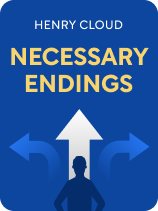

This article is an excerpt from the Shortform book guide to "Necessary Endings" by Henry Cloud. Shortform has the world's best summaries and analyses of books you should be reading.
Like this article? Sign up for a free trial here.
Can you judge a book by its cover? What type of people are the worst at relationships?
In Necessary Endings, Henry Cloud says that to determine who to let go of in life, you must assess relationships based on your impression of the other person’s character. Cloud claims that character is predictive of whether or not people will be receptive to change and feedback.
Keep reading to learn how to judge someone’s character.
Use Character to Assess Relationships
According to Cloud, people can generally be sorted into three categories based on their character. There are responsible people, irresponsible people, and dangerous people. Cloud offers different strategies for dealing with each type of person and learning how to judge someone’s character. (Cloud notes that people are too complicated to truly fall into three simple categories; however, these three categories can still be a useful heuristic for determining which relationships to end.)
(Shortform note: Many psychologists have created systems for comparing personality types, each with its own strengths and weaknesses. For example, the Myers-Briggs Type Indicator (MBTI), which is widely used in the business world, sorts people into 16 types. Supporters of the MBTI argue that it helps companies support employees, but critics note that there’s little scientific evidence that supports the MBTI. Other researchers believe that there are four personality types, though they note that there are numerous other ways to group people.)
1) Responsible people (Cloud refers to them as “wise people”): Responsible people are characterized by their ability to take ownership of their actions. They’re able to admit and apologize when their mistakes have hurt others, and they readily incorporate feedback and change unwanted behaviors.
Responsible people are by far the easiest group to deal with. Relationships with responsible people are often improved by open communication—if you tell them what they’re doing wrong, they’re likely to correct it on their own. Responsible people reward your investments in relationships with them. They benefit from coaching and education more than others. If you’re dealing with a responsible person, communicate openly and honestly, and you’re unlikely to have to end the relationship.
| Help Your Employees Behave Responsibly According to business psychologists, employees with a sense of ownership in the company behave more responsibly and productively. To increase the sense of ownership among your employees, these experts recommend assigning employees projects that affect their roles and allowing them to work on a given project from start to finish. These measures help your employees invest in their day-to-day tasks, encouraging them to act responsibly. As you enact measures to help your employees feel a sense of ownership, you should also strengthen your relationships with your employees. Business coaching experts note that employees only respond positively to coaching when managers understand their desires and motivations. As you get to know your employees more personally, request feedback on how best to support them—this information will help you to coach them more effectively in the future. |
2) Irresponsible people (Cloud refers to them as “fools”): As you might expect, irresponsible people are in many ways the polar opposites of responsible people. Irresponsible people are unable to take responsibility for their actions, instead finding an external factor to blame for any mistakes they make. When pressed about their behaviors, they’ll deflect or become heated and defensive.
(Shortform note: Psychologists note that defensive behavior often coincides with a neurological fight-or-flight response. In other words, people react defensively as a way of protecting themselves when feeling threatened. In these moments, people who get defensive feel that your criticism of their behavior is an attack on them as a person—in response, they use defensive tactics to try to protect themselves.)
When dealing with irresponsible people, it doesn’t always help to communicate directly about problem behaviors. Instead of critiquing specific misbehaviors, Cloud recommends calling out their overall inability to accept responsibility for their action. Point out to irresponsible people that they always find someone or something else to blame when things go wrong—this can sometimes help them change their patterns. Setting consequences also works well with irresponsible people, as it forces them to bear the weight of their own mistakes, which encourages them to change their behavior.
For example, suppose you’re struggling with an employee who habitually misses deadlines. Not only is this employee always behind schedule, they always have an excuse, always finding something or someone else to blame for their lateness. According to Cloud, trying to talk to them about their time management will be ineffective, as they’ll only continue to deflect responsibility. Instead, point out to the employee that they’re never accountable for their mistakes, and that their pattern of making excuses makes it difficult to manage them. By making them aware of their cycles of irresponsibility, you may help them begin the process of breaking those cycles.
It may not always be possible to improve relationships with irresponsible people. If you’ve tried communicating and setting consequences to no avail, Cloud recommends putting up boundaries to protect yourself. In some cases, this might mean bringing the relationship to an end.
| Set Boundaries With Irresponsible People Just as Cloud opines that consequences help irresponsible people change their behavior, in Set Boundaries, Find Peace, Nedra Glover Tawwab argues that you must enforce consequences for others to respect your boundaries. According to Tawwab, consequences serve a dual function—they communicate to others that your needs are serious, and they protect you from people who don’t respect your boundaries. Tawwab recommends limiting your time with irresponsible people, as it both protects you by limiting your exposure to them and strongly communicates that a change is needed. As you set boundaries with the irresponsible people in your life, be sure to speak up immediately when unwanted behaviors occur. Tawwab argues that communicating your discomfort in the moment helps to end uncomfortable situations as fast as possible, while also preventing resentment from building. |
3) Dangerous people (Cloud refers to them as “evil people”): Dangerous people are completely unlike the first two groups. Whereas both responsible and irresponsible people may sometimes cause harm by accident, dangerous people intend to harm others with their words and their actions. They are unsafe to be around.
None of the strategies we have listed are effective in dealing with dangerous people. According to Cloud, nothing you can do will change their behavior. Instead, end any and all relationships with dangerous people, and do your best to keep away from them. Cloud notes that deterrents, such as legal actions or calls to law enforcement, can be effective in keeping dangerous people away.
(Shortform note: In Why Does He Do That?, Lundy Bancroft describes dangerous people as “abusers.” According to Bancroft, abusers are people who intentionally harm others to get what they want. Like Cloud, Bancroft believes serious deterrents, such as arrests and litigation, can be used to curb abusive behavior. Beyond the individual level, Bancroft argues that to deal with dangerous, abusive people, you have to fight the cultural conditions that enable their actions. According to Bancroft, abusive behavior is often fueled by social imbalances in power due to money, race, gender, disability, or other criteria. Rectifying these power imbalances makes it more difficult for abusers to target vulnerable individuals.)

———End of Preview———
Like what you just read? Read the rest of the world's best book summary and analysis of Henry Cloud's "Necessary Endings" at Shortform.
Here's what you'll find in our full Necessary Endings summary:
- That pulling out of a bad situation is the best way to move forward in life
- How to assess which situations and relationships need to end
- How to make sure that your endings stick






